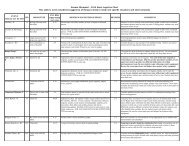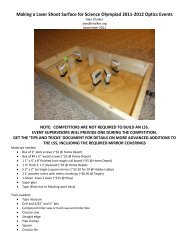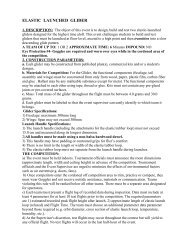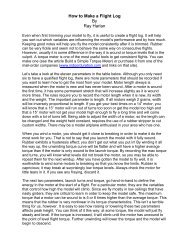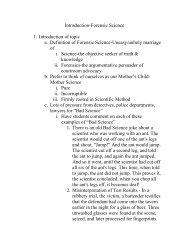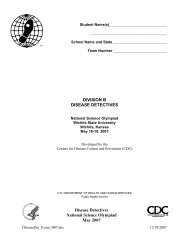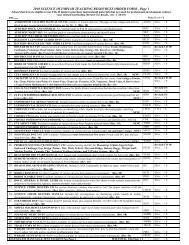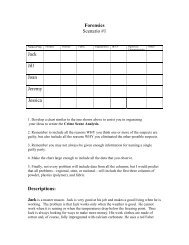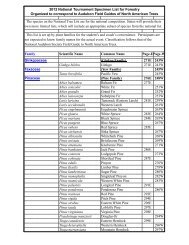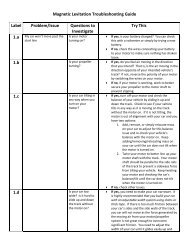Storm the Castle Energy Rule Tip Sheet for 2012 - Science Olympiad
Storm the Castle Energy Rule Tip Sheet for 2012 - Science Olympiad
Storm the Castle Energy Rule Tip Sheet for 2012 - Science Olympiad
You also want an ePaper? Increase the reach of your titles
YUMPU automatically turns print PDFs into web optimized ePapers that Google loves.
<strong>Storm</strong> <strong>the</strong> <strong>Castle</strong>: The <strong>Energy</strong> <strong>Rule</strong> <br />
Bruce Wiegand <br />
September 2011 <br />
<strong>Rule</strong> 3.e (“The <strong>Energy</strong> rule”) states: <br />
The device, without <strong>the</strong> counterweight and projectile, must not contribute energy to <strong>the</strong> launch. <br />
Example violations, allowable types, and mechanisms <strong>for</strong> testing <strong>for</strong> added energy are available on <br />
soinc.org. <br />
This document serves <strong>the</strong> purpose of showing <strong>the</strong> examples mentioned. It is intended to help students, <br />
coaches and event supervisors understand and en<strong>for</strong>ce this rule and thus reduce <strong>the</strong> number of clarification <br />
requests received. <br />
• Event supervisors have an obligation to provide an even playing field <strong>for</strong> all students. By ensuring <strong>the</strong> <br />
energy rule is followed, <strong>the</strong> event will be won by <strong>the</strong> team that has designed and built <strong>the</strong> best device <br />
and has tested <strong>the</strong> device to be able to accurately predict its per<strong>for</strong>mance. <br />
• Students should not try to build a device that adds energy to <strong>the</strong> launch; <strong>the</strong>y should focus on <br />
efficiency and consistency. This is <strong>the</strong> spirit of <strong>the</strong> event and all events in <strong>Science</strong> <strong>Olympiad</strong> (Note <strong>the</strong> <br />
General <strong>Rule</strong>s listed on <strong>the</strong> inside back cover of <strong>the</strong> <strong>Rule</strong>s Manual and at http://soinc.org/ethics_rules). <br />
• Coaches should check student built devices to ensure <strong>the</strong>y don’t add energy to <strong>the</strong> launch. Coaches <br />
would not want <strong>the</strong>ir students competing against a device that adds energy, so <strong>the</strong>y should have <br />
enough understanding of <strong>the</strong>ir team’s device to assure <strong>the</strong>y do not have a device that adds energy. <br />
Sections: <br />
• Fixed Fulcrum Trebuchet <br />
• Floating Arm Trebuchet <br />
• Wheels <br />
• Flexible Arms <br />
• O<strong>the</strong>r Devices <br />
1 Ver 1.0
Fixed Fulcrum Trebuchet <br />
The fixed fulcrum trebuchet is <strong>the</strong> easiest to check. A fixed point device without a sling (like a catapult) should <br />
be tested in <strong>the</strong> same manner as a fixed Fulcrum trebuchet. <br />
1. The device should be set up as if <strong>the</strong> student is ready to launch <strong>the</strong> device without <strong>the</strong> counterweight <br />
and projectile (<strong>the</strong> sling should be attached to <strong>the</strong> arm). <br />
2. The student should <strong>the</strong>n release <strong>the</strong> triggering device and <strong>the</strong> arm should not move in <strong>the</strong> direction of <br />
launch. <br />
3. The arm should be raised several inches and released, resulting in <strong>the</strong> arm ei<strong>the</strong>r staying in place or <br />
returning to launch position. The device should be checked <strong>the</strong> same way in several positions up to <strong>the</strong> <br />
90 degree position. <br />
4. During both of <strong>the</strong>se types of test, if <strong>the</strong> arm moves slowly in <strong>the</strong> launch direction and stops on its own, <br />
be<strong>for</strong>e <strong>the</strong> arm reaches 90 degrees in relation to <strong>the</strong> floor, <strong>the</strong> energy rule is not violated (provided <br />
<strong>the</strong>re is nothing else in place to stop <strong>the</strong> arm from moving to <strong>the</strong> 90 degree position.) <br />
Ready to launch position 90 degree position Balanced (not adding energy) <br />
Floating Arm Trebuchet <br />
The floating arm trebuchet is similar to a fixed fulcrum, with <strong>the</strong> exception that <strong>the</strong> fulcrum of <strong>the</strong> arm can <br />
move horizontally. <br />
1. This type of device needs to be checked in <strong>the</strong> same manner as a fixed Fulcrum device <br />
2. It should also be checked to ensure <strong>the</strong> arm does not roll downhill. <br />
3. This can be checked by having <strong>the</strong> trigger released and <strong>the</strong> arm slightly raised. When released <strong>the</strong> <br />
fulcrum point should not move <strong>for</strong>ward. <br />
2 Ver 1.0
Wheels: <br />
Wheels can be used to launch projectiles. <br />
• One way of doing it is to have a string attach <strong>the</strong> counterweight to <strong>the</strong> outer surface of <strong>the</strong> wheel. <br />
When <strong>the</strong> weight drops it rotates <strong>the</strong> wheel <strong>for</strong>ward and <strong>the</strong> projectile will ride in a holder and be <br />
released at <strong>the</strong> top of <strong>the</strong> wheel or be released when a stop is engaged. <br />
• Ano<strong>the</strong>r way is <strong>for</strong> <strong>the</strong> counterweight to be attached to <strong>the</strong> axle and have <strong>the</strong> projectile release on <strong>the</strong> <br />
second or third rotation. <br />
1. To test -‐ first have student explain how <strong>the</strong> device works. What is <strong>the</strong> direction of rotation? Does <strong>the</strong> <br />
device release be<strong>for</strong>e one rotation or after <strong>the</strong> device completes one? <br />
2. If <strong>the</strong> device does not complete a rotation you only have to test <strong>for</strong> energy to <strong>the</strong> release point. <br />
a. The device should be set up to launch without a counterweight and projectile. <br />
b. The trigger should <strong>the</strong>n be released and <strong>the</strong> wheel should not move in launch direction. <br />
c. The wheel should <strong>the</strong>n be rotated slowly in launch direction, <strong>the</strong>n stopped, and released. At <br />
this time <strong>the</strong> wheel should not move in launch direction. <br />
d. This should be checked in several locations, until <strong>the</strong> projectile release point has been reached. <br />
3. If <strong>the</strong> counter weight string attaches to <strong>the</strong> axle <strong>the</strong> device may make several rotations be<strong>for</strong>e release. <br />
a. Have <strong>the</strong> student set <strong>the</strong> device up <strong>for</strong> launch without counter weight and projectile. <br />
b. Release <strong>the</strong> trigger, and <strong>the</strong> device should not move in launch direction. <br />
c. Slowly pull <strong>the</strong> string to start rotation, stop <strong>the</strong> wheel and release it. <br />
d. The wheel should not move in launch direction. <br />
e. This must be checked <strong>for</strong> one complete revolution. <br />
Flexible Arms <br />
Many questions also come from flexible arms. <br />
1. If an arm is bent be<strong>for</strong>e <strong>the</strong> counterweight is installed it is storing its own elastic energy. <br />
2. This is generally tested by setting up <strong>the</strong> device <strong>for</strong> launch without <strong>the</strong> counterweight. <br />
3. When <strong>the</strong> trigger is released <strong>the</strong> arm springs <strong>for</strong>ward. <br />
4. If <strong>the</strong> arm is only bent when <strong>the</strong> counterweight is hung, it is only storing some of <strong>the</strong> energy of <strong>the</strong> <br />
counterweight. <br />
O<strong>the</strong>r Devices <br />
Many o<strong>the</strong>r devices can be built to launch projectiles. They all need to be checked to ensure <strong>the</strong>y do not <br />
violate <strong>the</strong> energy rule. O<strong>the</strong>r devices can be used but <strong>the</strong> same principles apply. <br />
1. Ask <strong>the</strong> students to demonstrate how <strong>the</strong> device works. <br />
2. Then put <strong>the</strong> device through a launch motion. <br />
3. The device should not move in launch direction without <strong>the</strong> counterweight. <br />
3 Ver 1.0



